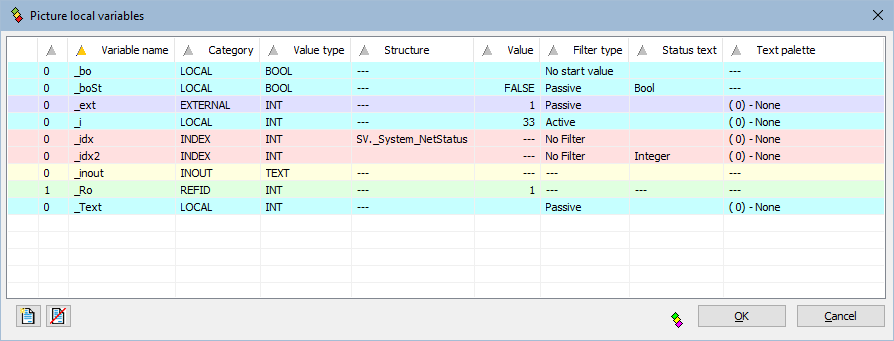Picture local variables
Local variables are variables that are valid within a picture instance. It means that the same picture opened on several consoles (D2000 HI processes) at the same time, uses its copies of local variables. Local variables are visible only within the picture script, they are not available on the system level. They can be connected to graphic objects and Windows controls.
There are five categories of picture local variables:
- Basic local variables – they have no special features and can be connected to objects and manipulate the object value.
- Input-output local variables – they allow to give parameters to the picture opened from other picture in both directions.
- Reference local variables - they are used for identification of graphic objects and Windows controls. Such variables are used as unambiguous identifiers of these objects within the picture script.
- Indexed - they are used to handle current displayed row of structured variable connected to graphic object to view.
- External - similar to Basic local variables, but the parameters can be set from a parent picture
Configuration of local variables
Clicking the button from the Main toolbar opens the dialog box allowing to configure local variables.
Definition of one local variable consists of the following attributes:
| First column | The column is used to select given local variable in the list. Double-click on the column corresponds to clicking the button OK in the dialog window. After inserting graphic objects from clipboard into picture, the column shows symbols for added local variable or name or definition conflict. |
| Second column | Shows how many times it is used in graphic objects of the picture (not in the picture scripts); does not apply to INOUT category. |
| Variable name | Local variable name. The name can be used either for connection to picture graphic object or in the picture script. The name must begin with the character '_' (underline). |
Category | Category of the local variable. According to selected category, local variables in the list are shown in corresponding colors:
|
| Value types | Local variable value type. Possible types:
|
| Structure | The attribute is valid only for the value type STRUCT and defines the object of Structure definition type, that determines the type of structured local variable. The attribute is also valid for index local variable that handles a filter (detailed description in index local variables below). |
| Value |
|
| Filter type |
|
| Status text | Object of Status text type that will be used for displaying the value of the local variable when it is connected to graphic object. |
| Text palette | Mask definition from transformation palette for value types INT, REAL, and TIME from LOCAL and INOUT categories. |
Note: Items without meaning are unavailable and are marked with ---
Use of local variables
Basic variables | They are used for connection to graphic objects / Windows controls. Connection is being performed in the palette Connect object - the tab Connect, Palettes, Control... Using such a connected local variable allows to read or modify the object contents and change the variable value. | ||
Input-output variables | They are used for parameter passing among pictures. Among pictures they are paired by name - when a picture is being opened from mother picture, the contents of mother picture variables is copied into input-output variables with the same names in the opened picture. Before closing the new picture, new contents of the input-output variables is copied to corresponding mother picture variables. | ||
Reference variables | They are used to name (identification) objects. There are three cases, you need to identify an object:
| ||
Indexed variables | They are used to handle current displayed row of structured variable connected to graphic object to view. Handling the value of indexed variable from the picture script you can change current connected structure row. The change of value in the picture ensures the change of value of variable but not the connected row of structure. Index variables can handle so-called filter. Filter allows optimization of the communication between the processes D2000 Server and D2000 HI by distribution of the values of the row defined by the indexed variable and not the values of whole structured variable. In the case, the indexed variable must be bound with an structured variable using the attribute Structure. Filter type is defined in the attribute Filter type:
When the filtering is enabled, value distribution can be also handled by the functions %HI_OpenRow, %HI_CloseRow, %HI_ChangeRow. | ||
| External variables | Parameters of values of external variables can be set from a parent picture, which displays this picture in visual display unit as a subpicture. When setting parameters from a parenting picture, it is possible to bind on such external variable other variable. Then, the external variable represents the value of this bound variable. Anz change of the bound variable will reflect into value change of the external variable. The binding applies in both directions, so the change of the external variable will cause change in the bound variable. The external variables are typically used when the picture is used as a component. It is possible to connect the external variables to graphic objects in the same way as the basic variables. |
Note:
List of local variables is sorted first by category (the column Category) and then by name (the column Variable name). Dialog box of local variables keeps the last sorting when it is reopened.
When a conflict occurs (see the chapter Inserting graphic objects from clipboard into picture), the list is sorted only by name.
Clicking on header of some column classifies the list downwards, next clicking classifies it upwards.
When the local variable is edited from the Connect object palette, tab Script, the appropriate row in the dialog window of local variables is highlighted by color (gray color).






Pridať komentár